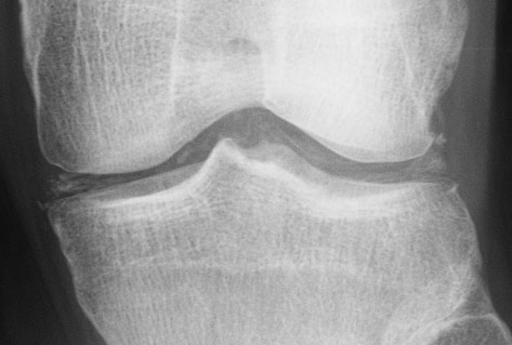Chondrocalcinosis
| Chondrocalcinosis | |
 | |
|---|---|
| Chondrocalcinosis of the articular and fibrocartilage of the left knee in a patient with calcium pyrophosphate dihydrate deposition disease (CPPD) | |
| ICD-10 | M11.1-M11.2 |
| ICD-9 | 712.3 |
| DiseasesDB | 10832 |
| MedlinePlus | 000421 |
| MeSH | D002805 |
Template:Search infobox Editor-In-Chief: C. Michael Gibson, M.S., M.D. [1]; Associate Editor(s)-in-Chief: Cafer Zorkun, M.D., Ph.D. [2] Luke Rusowicz-Orazem, B.S.
Synonyms and keywords: Pyrophosphate arthropathy; chondrocalcinosis; pseudogout; CPPD; Calcium pyrophosphate dihydrate deposition disease; CPPD disease
Overview
Calcium pyrophosphate deposition disease (CPPD) is a rheumatologic disorder with varied clinical manifestations due to precipitation of calcium pyrophosphate dihydrate crystals in the connective tissues. It is more commonly known by alternative names that specify certain clinical or radiographic findings, although neither is synonymous with CPPD. Pseudogout refers to the clinically evident acute synovitis with red, tender, and swollen joints that may resemble gouty arthritis (a similar condition with joint deposition of monosodium urate crystals). Chondrocalcinosis, on the other hand, refers to the radiographic evidence of calcification in hyaline and/or fibrocartilage. Pyrophosphate arthropathy is a term that may refer to either of the above, but is uncommonly used.
Causes
Life Threatening Causes
Causes by Organ System
| Cardiovascular | No underlying causes |
| Chemical/Poisoning | Breakdown of adenosine triphosphate |
| Dental | No underlying causes |
| Dermatologic | No underlying causes |
| Drug Side Effect | No underlying causes |
| Ear Nose Throat | No underlying causes |
| Endocrine | Acromegaly, Growth hormone secreting pituitary adenoma, Hypophosphatemia, Hypothyroidism |
| Environmental | No underlying causes |
| Gastroenterologic | Wilson's disease |
| Genetic | Alkaptonuria, Ochronosis, Wilson's disease |
| Hematologic | Hemochromatosis, Hypercalcemia , Hyperparathyroidism, Hypomagnesemia, Hypophosphatemia |
| Iatrogenic | No underlying causes |
| Infectious Disease | No underlying causes |
| Musculoskeletal/Orthopedic | Osteoarthritis |
| Neurologic | Hadd |
| Nutritional/Metabolic | Ochronosis |
| Obstetric/Gynecologic | No underlying causes |
| Oncologic | No underlying causes |
| Ophthalmologic | No underlying causes |
| Overdose/Toxicity | No underlying causes |
| Psychiatric | No underlying causes |
| Pulmonary | No underlying causes |
| Renal/Electrolyte | Oxalosis |
| Rheumatology/Immunology/Allergy | Arthritides, Familial chondrocalcinosis, Gout, Osteoarthritis |
| Sexual | No underlying causes |
| Trauma | Trauma |
| Urologic | No underlying causes |
| Miscellaneous | No underlying causes |
Causes in Alphabetical Order
Clinical aspects
CPPD crystal deposition disease is a polyarticular arthritis (i.e. it leads to an inflammation of several joints in the body), although it can initially present as monoarticular (i.e. confined to just one joint).
CPPD crystals tend to form within articular tissues. Diagnosis is by microscopy of fluid from a joint aspiration. Rhomboidal crystals should be seen under the microscope which exhibit weakly positive birefringence under polarized light. X-rays of the joint may show signs of chondrocalcinosis. Asymptomatic deposits can form in cartilage, joint capsules, intervertebral discs, tendons, and ligaments. Crystal deposition within cartilage (both hyaline and fibrocartilage) is known as chondrocalcinosis. Chondrocalcinosis initially is only visible microscopically, but if there is enough calcification, we can seen it radiographically as well. Common locations of chondrocalcinosis include the knees, wrists, elbows, and hips.
Crystal-induced synovitis is the result of shedding of crystals in the joint space after rupture of a CPPD deposit. Clinically this presents as an acute inflammatory synovitis very similar to that of an attack of gout, and has been referred to as "pseudogout."
- Other conditions associated with chondrocalcinosis:
Radiologic findings
Three main manifestations of CPPD deposition:
- chondrocalcinosis
- crystal induced synovitis (pseudogout syndrome)
- pyrophosphate arthropathy
Treatment
Treatment of CPPD is mostly aimed at preventing further crystal formation and reducing symptoms from crystal deposition. CPPD crystal deposition cannot be reversed. If CPPD results from underlying metabolic abnormalities (hyperparathyroidism, hemochromatosis, hypophosphatasia, or hypomagnesemia)[1], these can be treated directly.
For symptomatic joints, treatment is similar to treatment of gout. When a single joint is involved, joint aspiration and intra-articular corticosteroid injection is often used, in addition to NSAIDs and/or colchicine. When multiple joints are involved, joint injection is often impractical, or limited only to the most severely involved joint, and oral systemic treatment is chosen instead.
Because pyrophosphate complexes with magnesium prior to its degradation [2], and CPPD can result from pathologically low magnesium levels, magnesium supplementation may be of help, particularly in a few patients with underlying hypomagnesemia. It may be possible to end attacks by ingesting large (maximum RDA) doses of magnesium supplement accompanied by vitamin B6 to help absorption. What that does is assist the body in re-dissolving the calcium in the joint fluid, and with maintenance doses, often in the form of snacking on magnesium-rich foods such as almonds, further attacks can be prevented altogether - without medication.
References
- ↑ Wright G.D., Doherty M. Calcium pyrophosphate crystal deposition is not always 'wear and tear' or aging. Ann Rheum Dis.1997; 56: 586-588 PMID 9389218
- ↑ Wright G.D., Doherty M. Calcium pyrophosphate crystal deposition is not always 'wear and tear' or aging. Ann Rheum Dis.1997; 56: 586-588 PMID 9389218
Template:Diseases of the musculoskeletal system and connective tissue
de:Pseudogicht
sv:Pyrofosfatsynovit